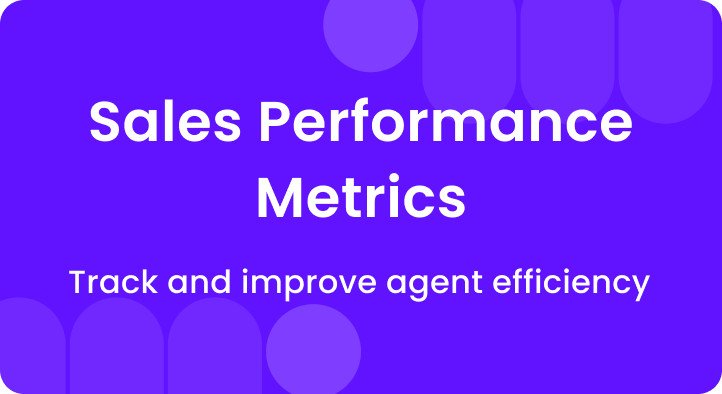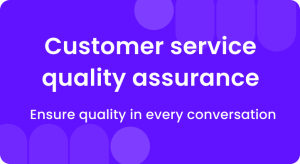Sales is a multifaceted process that involves building relationships, providing solutions, communication, and negotiation, and finally – closing the deal.
All of these activities contribute to the ultimate goal of a sale, but their effectiveness can be subjective and difficult to measure without data and the right metrics.
The lack of specific sales performance metrics makes it difficult to pinpoint the root causes of declining sales and areas of improvement.
Sales metrics provide that objective measure to identify areas of improvement, ultimately leading to a more successful sales operation.
But which key metrics should you track, and why?
We’ve compiled 13 crucial sales performance metrics that you should track in 2025 to assess the effectiveness of your sales process and make informed decisions.
Let’s go
Upload Call & Get Insights
 DOWNLOAD DUMMY FILE
DOWNLOAD DUMMY FILE A. What Are Sales Performance Metrics?
Sales performance metrics are quantitative indicators that measure specific aspects of the sales process from lead generation to deal closure. Unlike broader KPIs, these metrics offer granular insights into each sales funnel stage.
For instance, revenue growth is a KPI because it tells you about the overall performance of your company.
Sales performance metrics like number of leads generated measure a particular aspect of the sales process.
B. Top 13 Sales Performance Metrics You Should Track in 2025
Here are the top 13 sales performance metrics you should track in 2025 to close more deals and boost your revenue:
1. Sales Growth
Percent increase in sales over a period.
It’s vital for assessing the overall health of your sales organization.
Tracking sales growth helps you measure your progress toward your sales goals and identify trends in your sales performance.
Here's how you can calculate sales growth rate
Sales Growth Rate = (Current Period Sales – Prior Period Sales) / Prior Period Sales * 100
For example, if your company’s sales were $100,000 in the previous month and $125,000 in the current month, then:
Sales Growth Rate = ($125,000 – $100,000) / $100,000 * 100 = 25%
This indicates a 25% increase in sales from the previous month.
Use: Evaluates overall health and momentum.
2. Sales Target Attainment
Sales target is a predetermined value of products or services you aim to sell within a given time period. (Actual sales as a percentage of set target)
But why is this metric important? Harvard Business Review puts it aptly:
“When 10%–20% of salespeople miss goals, the problem might be the salespeople. But when most salespeople miss, the problem is their goals.”
Setting realistic and attainable goals is crucial to ensure your sales teams’ efforts are focused.
You can calculate the sales target attainment metric to measure your performance against the sales target to make better decisions.
Here's how you can calculate sales target:
Sales Target Attainment = (Sales for the current period / Sales target) * 100
For instance, if your sales target for a month was $5,000 and your actual sales for that month were $3,000, your sales target attainment would be:
Sales Target Attainment = ($3,000 / $5,000) x 100 = 60%
This indicates you achieved 80% of your sales target for that month.
Use: Measures goal alignment low attainment, if widespread, can indicate unrealistic targets (as per HBR quote).
3. Sales by Region

Sales by region is a statistic that measures your sales performance across many geographic areas.
To determine sales by region, gather your data, ideally including:
- Sales amount: Individual transaction values for a specific period (e.g., daily, weekly, monthly).
- Region: Geographic areas like country, state, province, city, or any other relevant for your analysis.
Tracking sales by region lets you better manage resources and personalize your sales approach for each market.
For instance, let’s say you see strong sales in the west coast of the US but low sales on the east coast.
You can target marketing campaigns towards East Coast preferences or open stores there.
Use: Identifies regional performance differences, helps reallocate resources, or tailor marketing.
4. Sales by Product

Sales by product is a statistic that measures your sales success for specific items or services.
Segment your sales data by product as you would for sales by area.
Your sales CRM software should allow you to produce reports with sales numbers for each product.
Tracking sales by product allows you to discover your best performers.
Use this data to inform product development, marketing, and price decisions.
Use: Helps identify top-performing offerings.
5. Lead Conversion Rate
Percentage of leads that convert into paying customers.
The lead conversion rate evaluates the efficacy of your lead generation and sales qualifying strategies.
“Uriel Sabbsh, Sales Head at Gen Next Mortgage, emphasizes that employee effort and lead quality are important KPIs, however in the financial sector, the conversion rate is the most crucial sales performance metric for assessing.”
For instance, a poor lead conversion rate might indicate improvement in communication skills.
You can use speech analytics to help identify communication patterns and objections that lead to successful closes.
Here's how to calculate the lead conversion rate:
Lead Conversion Rate = (Number of Leads Converted) / (Total Number of Leads) x 100%
For instance, your website generated 100 leads last month, and 20 of those leads converted into paying customers. Your lead conversion rate would be:
Lead Conversion Rate = (20 Converted Leads) / (100 Total Leads) x 100% = 20%
Use: Measures effectiveness of lead-generation and qualifying strategies.
6. Customer Acquisition Cost (CAC)
Customer Acquisition Cost (CAC) is the overall cost of acquiring a new client.
It includes marketing expenditures, sales, and other operations costs.
Tracking CAC allows you to see how much it costs to acquire a new customer.
A high CAC value lets you know to consider more cost-effective strategies to acquire consumers.
= (Cost of Sales + Cost of Marketing) / Number of New Customers
Here:
- Cost of Sales refers to the total amount used by sales teams to acquire customers (e.g., commissions, salaries, bonuses)
- Cost of Marketing refers to all expenses related to marketing activities that generate new customers (e.g., advertising, social media marketing, content creation)
- Number of New Customers are the customers acquired in a specific time period (e.g., month, quarter, year)
7. Customer Lifetime Value (CLV)
Customer Lifetime Value (CLV) is a metric that predicts the total revenue a single customer will generate throughout their entire relationship with your business.
Tracking CLV helps you understand your clients’ long-term value.
CLV can be used to create client retention strategies and support investments in customer service and loyalty programs.
= Customer Value * Average Customer Lifespan
Here:
- Average purchase value: This is computed by dividing your total income by the number of clients you have in a given period.
- Average Customer Lifespan: This is estimated by reviewing your previous customer data.
8. Average Purchase Value
The Average Purchase Value (APV) is the average amount of money a client spends on a single purchase.
Tracking APV lets you discover how much income you generate for each client.
This knowledge can help you establish a company strategy.
For example, upselling and cross-selling are excellent tactics for increasing average customer spending.
= Total Revenue / Number of Purchases
9. Sales Cycle Length

The average sales cycle duration is a key sales performance metric that measures the time it takes to consummate a business, from lead generation to contract signing.
Tracking the duration of a sales cycle can help you uncover bottlenecks in your sales process and development opportunities.
A protracted sales cycle suggests that your lead qualifying procedure needs to be corrected.
= Σ (Sale Closed Date – Lead Created Date) / Number of Deals
10. Opportunity-to-Win Ratio
The opportunity-to-win ratio is the percentage of sales opportunities that lead to concluded agreements.
The opportunity-to-win ratio is a key measure of the effectiveness of your sales process.
It also acts as a quality assurance check for your sales funnel, indicating areas for improvement.
(Number of Won Opportunities / Number of Closed Opportunities) x 100%
A low opportunity-to-win ratio indicates that your salespeople are pursuing unqualified prospects.
It might also indicate that your sales qualifying procedure needs to be tightened.
11. Churn Rate
The churn rate is the percentage of consumers who cancel their subscriptions or quit doing business with you within a specific period.
Tracking churn rate allows you to determine how many clients you are losing and why they are departing.
A high turnover rate implies poor customer service. It might also indicate product dissatisfaction.
Here's how to calculate the churn rate
Churn Rate = (Lost Customers ÷ Total Customers at the Start of Time Period) x 100
For example, if you started a month with 250 customers and lost 10 customers by the end, you would have a 4% monthly churn rate.
While a 5% churn rate or lower is considered ideal, anything above 10% suggests a need to revisit your customer experience.
12. Pipeline Coverage
Pipeline coverage is a statistic that compares the potential income in your sales pipeline to your sales quota.
This metric helps you forecast future sales and assess whether you have a sufficient pool of potential deals to reach your targets.
= Total Pipeline Value / Total Quota
Here:
- Total Pipeline Value refers to the sum of the expected value of all your current sales opportunities within a specific timeframe (e.g., month, quarter, year).
- Total Quota represents your sales target or goal for the same timeframe you’re measuring pipeline value.
Remember: Pipeline coverage is a strong indicator, but it’s best to analyze it alongside other sales metrics like win rates, average deal size, and sales cycle length to get a clearer picture of your lead quality and overall sales health.
13. Quota Attainment
Quota attainment is the proportion of your sales quota that your sales team met over a specific time.
Tracking quota attainment allows you to evaluate your sales team’s and individual salespeople’s success. It also helps you discover areas where your sales training can be provided.
Formula of Quota Attainment = (Actual Sales / Sales Quota) x 100
Here:
- Actual Sales is the total amount of sales achieved during a specific period (e.g., month, quarter, year).
- Sales Quota represents the sales target or goal set for that same period.
C. How Can Tracking Sales Metrics Improve Sales Performance?
When you measure sales metrics, you obtain helpful information about your sales processes, customer behavior, and market trends. Analyzing these data points can dramatically improve your sales KPIs results. Here’s how:
- Understanding what works best allows you to adjust your strategy. This improves sales efficiency and efficacy.
- Utilizing the sales KPIs to deliver customized coaching and training lets you focus on areas of improvement while maximizing your sales team’s strengths.
- Forecasting future income streams allows you to change your plans proactively, helping you stay ahead of the curve.
Conclusion
Following these 13 key sales performance metrics in 2025 can help you gain valuable insights to improve your sales channels and achieve long-term success.
This data empowers data-driven decisions, identifies improvement areas, and ultimately drives more sales.
What you can do with sales performance metrics becomes more impactful with an AI-powered conversation intelligence platform like Enthu.AI.
It goes beyond traditional call monitoring by providing deeper insights into performance and sales coaching opportunities.
FAQs
1. What are the key advantages of measuring sales metrics?
Tracking sales data helps firms evaluate their performance, find areas for development, and optimize sales methods for better outcomes.
2. How frequently should sales metrics be reviewed?
Regular assessments, such as monthly or quarterly, are essential for making timely changes to sales strategy. Sales targets should be updated to reflect current performance patterns.
3. What technologies can help you track sales data effectively?
Sales discussions are monitored using tools such as conversation intelligence systems. CRM systems and sales analytics software also provide powerful tools for effortlessly examining sales information.
4. What is sales performance metric?
Sales performance management (SPM) optimizes and tracks sales team performance by setting targets, monitoring progress, and providing tools to help salespeople achieve their goals and quotas.
5. how to track sales performance?
Start with the basics: conversion rate, deal size, pipeline velocity, and win rate. Then add call analytics and rep activity data from your CRM or AI tools. The goal: spot what’s working, who’s closing, and where leads drop off.
6. What metrics help evaluate AI performance in sales?
Look at lead scoring accuracy, meeting booking rate, response time, and revenue influenced by AI. Also track AI call summaries’ accuracy and recommendation-to-conversion ratio. If AI isn’t saving time or improving close rates, it’s not performing.




 On this page
On this page


